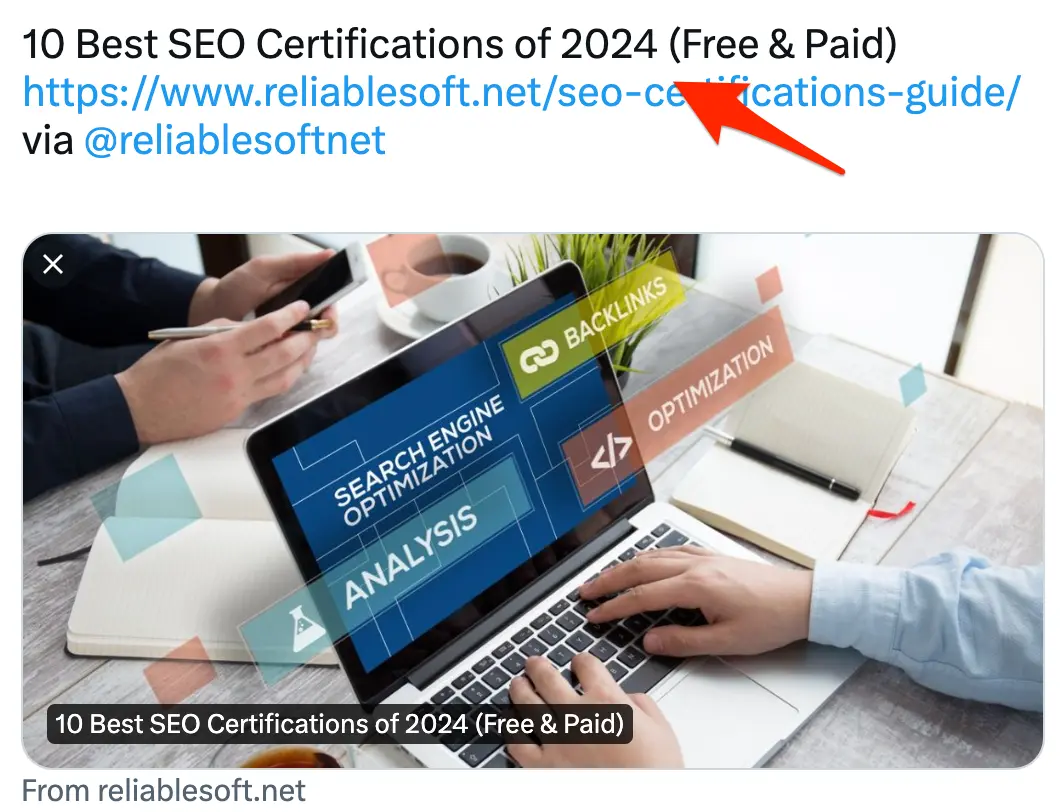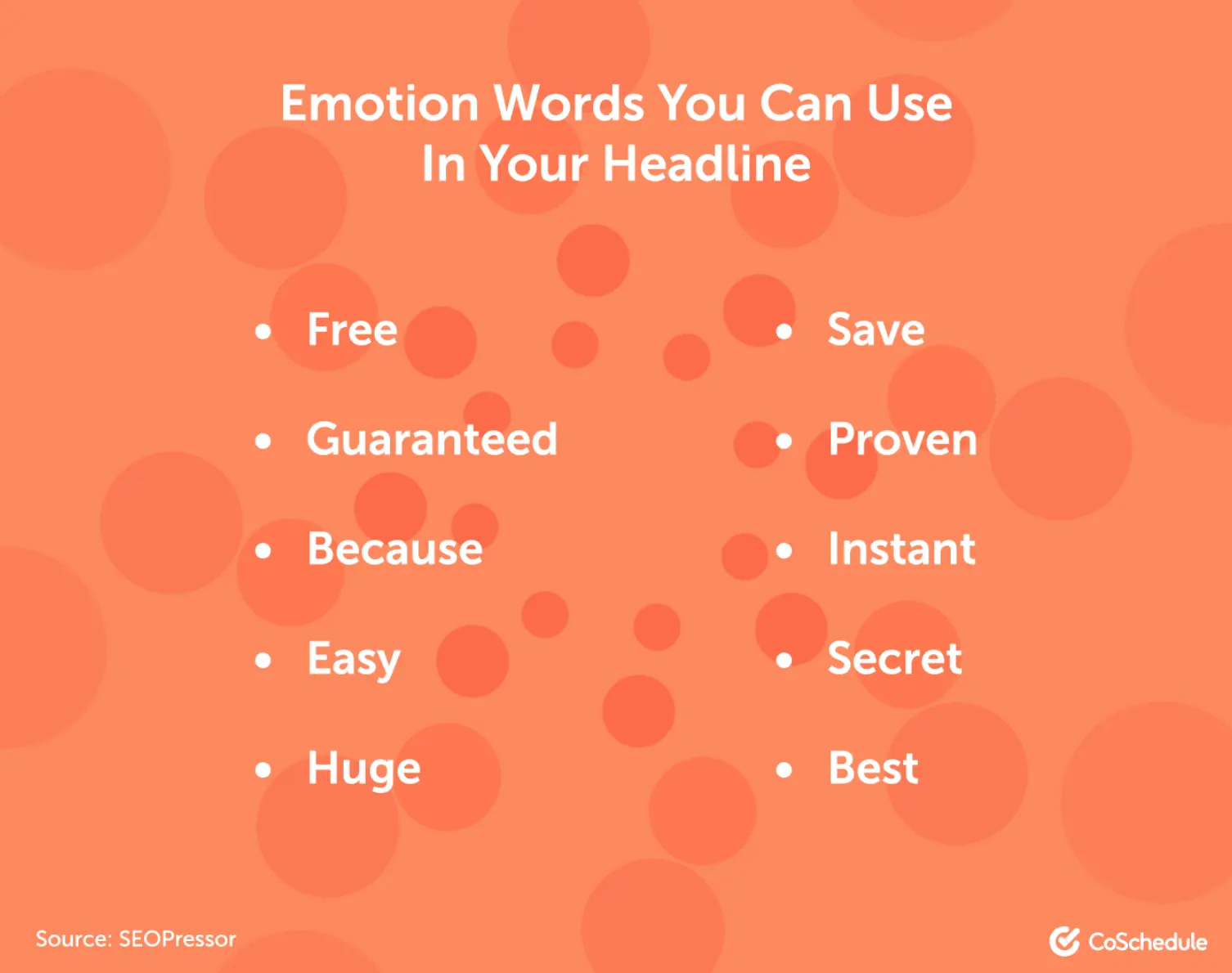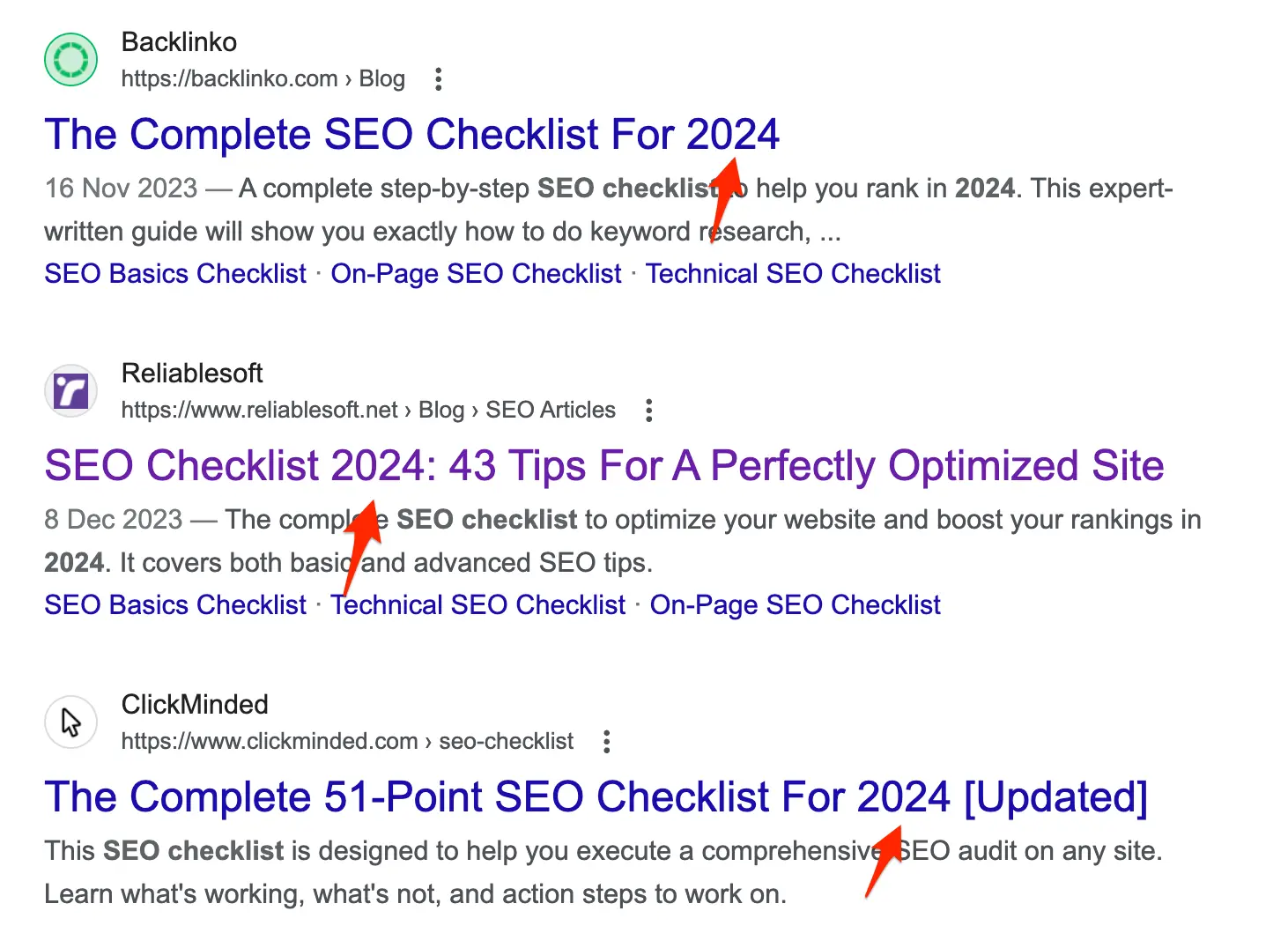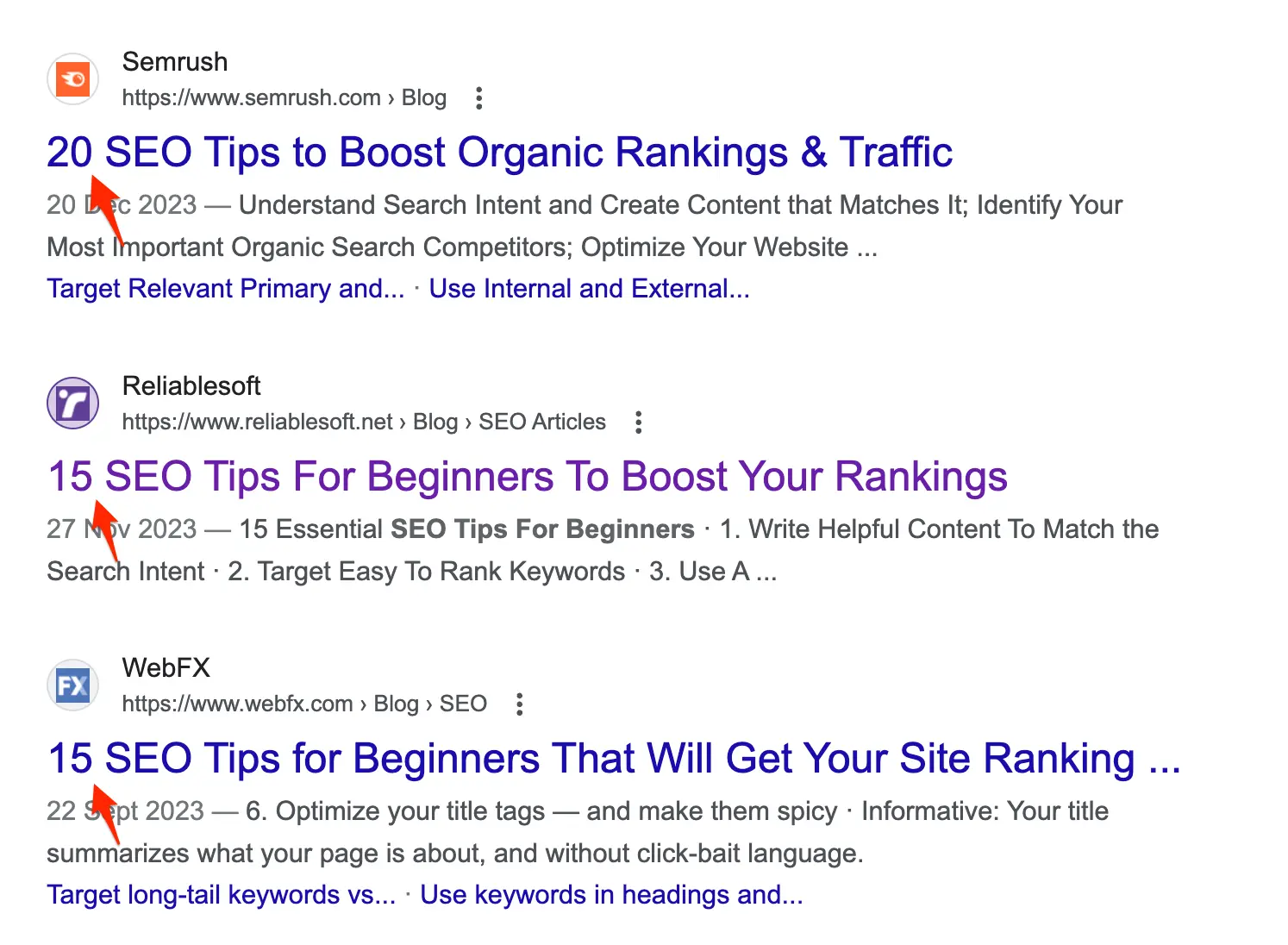What Is A Title Tag?
The title tag is an HTML element used to specify the title of a webpage. It is shown in the SERPs (search engine results pages), in the browser tab, and in link previews for the page. It is also referred to as SEO Title.
Here is an example of a title tag in HTML:

This is how it looks in the Google SERPS:

In the browser tab:

And when the page is shared on social media:

Why Are Title Tags Important For SEO?
Title tags are very important for SEO for three main reasons.
- The title tag is shown in the search results and impacts your CTR and, thus, your traffic.
- It gives search engines a big hint about what the page is about and can influence your ranking position.
- Title tags appear in the preview of a post when shared on social media. A good title will encourage more users to click on the post.
Title Tags Vs. H1 Tag
Many people tend to confuse page titles with the H1 tag. The title tag is defined in the <head> section and is not visible on the page but is shown in the search results, while the H1 tag is part of the <body> of a page and is visible on the page.
By default, they have the same value, but providing slightly different values of your title tag and H1 is okay. You can read the differences and best practices here.
How To Write Good SEO Titles (Best Practices)
Follow these best practices to write SEO-friendly titles:
- Write Unique Titles Tags For Each Page
- Make Titles Relevant To The Page Content
- Optimize The Title Length
- Include Your Primary Keywords
- Create Titles For Users, Not Search Engines
- Make Your Titles Clickable
1. Write Unique Titles Tags For Each Page
Each page (including your homepage) should have a unique title. This helps search engines understand how the particular page is distinct from other pages on your website.
Remember that one of the most complicated tasks search engine crawlers have to perform during the indexing process is to understand the content and context of a page, and the page title is a great way to help them in that manner.
Besides having unique titles for all your pages, you should also analyze the SERPS to see what kind of titles work well for your target keywords.
You should ensure that your titles are not the same as your competitors but different. Google rarely shows pages having exactly the same title and it's a great way to make your titles interesting and attract more clicks.
Here is an example of unique titles in Google SERPS for the query "SEO Titles".

Note: If you are running an eCommerce website, read my post on homepage SEO for more tips on optimizing the home page title of an eCommerce website.
2. Make Titles Relevant To The Page Content
A page title should accurately describe the page content. Think of the title as a very short summary of the page. This helps search engines understand the page and assures users they're in the right place.
To ensure relevance, closely align your title with the core theme of your content. If your page offers a detailed guide on 'Advanced Email Marketing Strategies,' your title should reflect this specific focus. Titles like 'The Complete Guide to Advanced Email Marketing: Strategies and Tips' work well as they precisely indicate what the page offers.
Don’t try to trick search engines by providing a title not supported by the content. This bad SEO practice can destroy your rankings because of pogo-sticking.
Pogo sticking is the term used to describe the process where a user is searching something on Google, clicks on one of the top results, visits a page but doesn’t find it interesting, and goes back to the search results and clicks on the second listing, etc.
Google can identify this user behavior and pattern, and if many users are doing the same thing, they are not satisfied with the Google search results.
Google algorithms will then push the rankings of the particular pages down and show other pages to users until pogo-sticking is reduced, indicating that users are happy with the listed results.
3. Optimize The Title Length
Titles should be brief and informative, typically between 50 and 60 characters.
Most SEO experts and tools use this guideline because this is, on average, the number of characters shown in Google search results for the title of a snippet.
So, one of the reasons you should prefer short titles over longer ones is to ensure that your title will be shown without breaks in the SERPS, providing a better user experience and a higher organic CTR.
To gain space and make your titles the optimum length:
- Do not include your domain name in the title. This is added automatically by Google when it makes sense.
- Use shortened versions of words. For example, instead of writing 'and,' you can use '&' or 'w/' instead of 'with.'
- Don't use ALL Capitals; they take up more space and can appear aggressive or spammy to users.
Here is an example:

4. Include Your Primary Keywords
Titles should include your target keywords. This is extremely important, and not against any Google guidelines; on the contrary, this is a good SEO practice.
Add your primary keyword at the beginning of the title to grab the user's attention.
See below for an example of how to do this without exaggerations. Keyword stuffing (i.e., repeating variations of the same keyword) in the title (and your content in general) should be avoided.

5. Create Titles For Users, Not Search Engines
Your titles should be interesting enough to catch the attention of the users.
Here are some easy guidelines to follow to create catchy titles that are both SEO-friendly and user-friendly.
Use Emotional Words
In a study by Co-schedule, they found out that posts with emotional headlines get more shares. Words like "free, guaranteed, proven, easy, best, save, huge" can positively impact a title's CTR.

Add Brackets
This is another technique I’m using that is also backed by research. Titles with brackets have a 33% higher CTR than post titles without brackets. HubSpot and Outbrain performed the study after analyzing more than 3M headlines.
Use Dates
Including the current year or a specific date range in your title can signal relevance and timeliness. For example, 'Top Digital Marketing Strategies [2024]' instantly communicates that the content is up-to-date. This can be especially effective for topics that change frequently, assuring the reader they get the latest information.

Use Numbers
Incorporating numbers into your title can make it more attractive and specific. For example, '7 Proven Strategies to Increase Your Website Traffic' is more compelling. Numbers suggest concrete, digestible information and help set expectations for the reader about the content's structure and depth.

6. Make Your Titles Clickable
Here are a few more techniques to increase the likelihood of users clicking on your titles in search results or social media platforms.
Ask a Question: Titles framed as questions can spark curiosity. For example, 'Why is Digital Marketing Essential for Businesses in 2024?' This kind of title invites the reader to find the answer, increasing the likelihood of a click.
Offer a Solution: People often search for solutions to their problems. Use your title to suggest that your content has the answers. Titles like 'How to Boost Your SEO Rankings in 5 Easy Steps' indicate that your content is informative and practical.
Use Positive or Negative Superlatives: Superlatives like 'Best' or 'Worst' can draw attention. They set an expectation of definitive, high-value content, as in 'The Best Strategies for Social Media Marketing .'
Common SEO Title Tag Mistakes
Besides following best practices when writing your page titles, it is equally important to avoid these mistakes.
Keyword Stuffing: In the past, having exact match titles (especially for long tail keywords) was recommended, but this is no longer the case after the introduction of Rank Brain.
What you should do instead is to carry out your keyword research and find out the long-tail keywords to target and then use them as part of your title and not as your title.
Here is an example:
Instead of a stuffed title like 'Local SEO Strategies, Local SEO Tips, Local SEO Marketing,' use a better alternative like 'Local SEO Strategies: 10 Proven Tips'.
This title integrates your primary keyword, 'Local SEO Strategies,' and is more appealing and informative. It indicates the content's focus on practical advice and strategies, making it SEO-friendly and attractive to your target audience.
Tool Long or Too Short Titles: Titles that are too long may be cut off, leading to incomplete or confusing messages. Too short-titles are not helpful for users or search engine crawlers.
Missing <Title> Tag: It may sound weird, but some websites (especially if they were developed years ago) don't provide a valid <title> tag in the header. To be safe, use our instructions below to confirm that your theme is properly configured to output the title tag in the page's header.
Duplicate Titles Across Pages: Using the same title tag for multiple pages can confuse search engines and users, leading to lower rankings and click-through rates. An easy to check this is to view the contents of your XML sitemap or run an SEO audit using a tool.
How To Review And Update Your Title Tags
There are 2 easy ways to check the value of a <title> tag for any page.
- Open a new browser window and navigate to the page URL. Right-click anywhere on the page and select VIEW SOURCE. Press CTRL-F and search for <title>. Whatever is enclosed in <title></title> is the page title.
- Another way to view the page title is to move your mouse over the browser tab window.
How To Update Your Page Titles
If you're on WordPress and using the Yoast SEO Plugin, there is an "SEO TITLE" field when you edit a page or post. Changing this value will update your SEO title.

If you're using a different plugin or CMS, look for "Page Title" or "SEO Title" and change the value there. After saving your changes, use the above techniques to check the value of the <title> tag in the HTML code.
Learn More About On-Page SEO
Optimizing your title tags is only one of the elements of on-page SEO. Use the guides below to learn more techniques and best practices.



